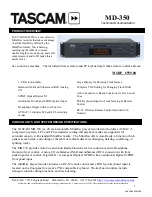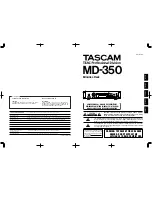
69
RQT9048
Ref
erence
Glossary
Bitstream
This is a signal compressed and converted into digital form. It is converted
back to a multi-channel audio signal, e.g., 5.1-channel, by a decoder.
CPRM (Content Protection for Recordable Media)
CPRM is technology used to protect broadcasts that are allowed to
be recorded only once. Such broadcasts can be recorded only with
CPRM-compatible recorders and discs.
Decoder
A decoder restores the coded audio signals on DVDs to normal. This
is called decoding.
Dolby Digital
This is a method of coding digital signals developed by Dolby
Laboratories. Apart from stereo (2-channel) audio, these signals can
also be multi-channel audio. A large amount of audio information can
be recorded on one disc using this method.
Down-mixing
This is the process of remixing the multi-channel audio found on some discs
into two channels. It is useful when you want to listen to the 5.1-channel audio
recorded on DVDs through your TV’s speakers. Some discs prohibit down-mixing.
If this is the case, this unit can only output the front two channels.
DTS (Digital Theater Systems)
This surround system is used in many movie theaters. There is good
separation between the channels, so realistic sound effects are possible.
Dynamic range
Dynamic range is the difference between the lowest level of sound that can be heard
above the noise of the equipment and the highest level of sound before distortion
occurs. Dynamic range compression means reducing the gap between the loudest
and softest sounds. This means you can hear dialog clearly at low volume.
Film and Video
DVD-Video are recorded using either film or video. The unit can
determine which type has been used, then uses the most suitable
method of progressive output.
Film is 24 or 30 frames per second, with motion picture film generally
being 24 frames per second.
Video is 60 fields per second (2 fields making up 1 frame).
Finalize
A process that makes play of a recorded CD-R, CD-RW, DVD-R, etc.
possible on equipment that can play such media. You can finalize DVD-R,
DVD-R DL, DVD-RW (DVD-Video format), +R,and +R DL on the unit. After
finalizing, the disc becomes play-only and you can no longer record or edit.
However, finalized DVD-RW can be formatted to become recordable.
Folder
This is a place on the memory card where groups of data are stored
together. In the case of this unit, it refers to the place where still
pictures (JPEG) are stored.
Formatting
Formatting is the process of making media such as DVD-RAM
recordable on recording equipment.
You can format DVD-RAM, DVD-RW (only as DVD-Video format),
+RW and SD card on this unit.
Formatting irrevocably erases all contents.
Frame and field
Frame refers to the single images that constitute the video you see
on your TV. Each frame consists of 2 fields.
u
r
Frame
Field
Field
A frame still shows 2 fields, so there may be some blurring
between them, but picture quality is generally better.
A field still shows less picture information so it may be rougher, but
there is no blurring.
•
•
HDMI (High-Definition Multimedia Interface)
HDMI is a next-generation digital interface for consumer
electronic products. Unlike conventional connections, it transmits
uncompressed digital video and audio signals on a single cable. This
unit supports high-definition video output (720p, 1080i, and 1080p)
from HDMI AV OUT terminal. To enjoy high-definition video a high
definition compatible television is required.
JPEG (Joint Photographic Experts Group)
This is a system used for compressing/decoding color still pictures.
If you select JPEG as the storage system on digital cameras, etc.,
the data will be compressed to 1/10-1/100 of its original size. The
benefit of JPEG is less deterioration in picture quality considering
the degree of compression.
MP3 (MPEG Audio Layer 3)
An audio compression method that compresses audio to
approximately one-tenth of its size without any significant loss of
audio quality.
Pan & Scan/Letterbox
In general, DVD-Video are produced with the intention that they will
be viewed on a widescreen TV (16:9 aspect ratio), so images often
don’t fit regular TVs (4:3 aspect ratio). 2 styles of picture, “Pan &
Scan” and “Letterbox”, deal with this problem.
Pan & Scan: The sides are cut off so the picture
fills the screen.
Letterbox:
Black bands appear at the top and
bottom of the picture so the picture
itself appears in an aspect ratio of 16:9.
Progressive/Interlace
NTSC, the video signal standard, has 480 interlaced (i) scan lines,
whereas progressive scanning uses twice the number of scan lines.
This is called 480p.
Using progressive output, you can enjoy the high-resolution video
recorded on media such as DVD-Video.
Your TV must be compatible to enjoy progressive video.
Protection
You can prevent accidental erasure by setting writing protection or
erasure protection.
Sampling frequency
Sampling is the process of converting the heights of sound wave
(analog signal) samples taken at set periods into digits (digital
encoding). Sampling frequency is the number of samples taken per
second, so larger numbers mean more faithful reproduction of the
original sound.
Thumbnail
This refers to a miniature representation of a picture used to display
multiple pictures in the form of a matrix.
1080i
In one high definition image, 1080 alternating scan lines pass every
1/60th of a second to create an interlace image. Because 1080i
more than doubles current television broadcasts of 480i, the detail is
much clearer and creates a more realistic and rich image.
1080p
In one high definition image, 1080 scan lines pass at the same
time every 1/60th of a second to create a progressive image. Since
progressive video does not alternate scan lines like interlace, there
is a minimal amount of screen flicker.
720p
In one high definition image, 720 scan lines pass at the same time
every 1/60th of a second to create a progressive image. Since
progressive video does not alternate scan lines like interlace, there
is a minimal amount of screen flicker.








































